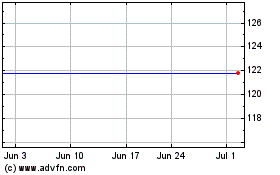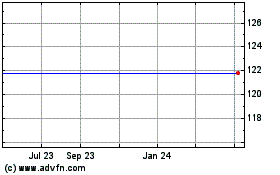Chevron to Sell Assets in Asia Worth Up to $5 Billion--Update
August 04 2016 - 10:22AM
Dow Jones News
By Kane Wu and Dan Strumpf
HONG KONG -- Chevron Corp. is paring its Asia operations,
selling assets worth up to $5 billion in an effort to raise cash,
according to people familiar with the situation.
The California-based energy giant is set to begin selling its
offshore China assets this month, the latest in a series of
divestments in Asia. The company is looking to raise up to $10
billion globally from asset sales, a big chunk of which will come
from its Asia upstream operations, as part of a broader effort to
cut costs and adapt to an environment of lower oil prices.
Among the assets Chevron is looking to sell is its stake in an
offshore oil field production venture with China's state-owned oil
company Cnooc Ltd., which could fetch as much as $1 billion,
according to people familiar with the situation.
The asset could be attractive to a range potential bidders
including Chinese energy companies and sovereign funds, according
to people familiar with the situation.
Chevron is also shopping its geothermal assets in Indonesia, the
people said. The company is weighing bids worth more than $2
billion, according to one person. Geothermal energy uses steam
extracted from underground to generate electricity.
Chevron is also selling natural gas field assets in Thailand,
according to people familiar with that deal.
The proposed sales would mark a meaningful reduction in
Chevron's footprint in oil and gas production in Asia. The company
continues to operate a natural-gas production business in
Bangladesh and onshore in China, as well as offshore production in
Indonesia.
Some locales in Asia are still attracting investment from
Chevron. In May, for example, a Chevron-led consortium announced
$37 billion in new spending to expand an oil project in Kazakhstan
known as Tengiz, one of the biggest energy investments in
years.
Chevron's retrenchment in Asia comes as the global energy
industry continues to cope with an oil-market slump that earlier
this year sent prices to 12-year lows. Prices saw a brief rally
over the last few months but re-entered a bear market this
week.
Chevron reported a $1.5 billion loss in the latest quarter --
its third-straight period in the red -- as depressed oil prices
continued to drag on its results, although the company's revenue
decline was less than analysts anticipated. The company also took
$2.8 bilSHYlion of imSHYpairSHYments and other nonSHYcash
charges.
Chief ExSHYecSHYuSHYtive John WatSHYson said the company's poor
performance reSHYflected "our onSHYgoSHYing adSHYjustSHYment to a
lower-oil-price world." In the secSHYond quarSHYter, the
comSHYpaSHYny's avSHYerSHYage sales price per barSHYrel of crude
oil and natSHYural gas liqSHYuids was $36, down from $50 a year
ago.
The Asia deals are part of a broader program of asset sales that
Chevron is undertaking. The company had said in January it is
looking to sell up to $10 billion in oil-field and other assets
through 2017. Of that target, it has already completed $1.4 billion
worth of sales.
Chevron is also cutting 8,000 jobs -- around 12% of its
workSHYforce -- and slashing bilSHYlions of dolSHYlars from its
capSHYiSHYtal-spendSHYing budSHYget, it said last week.
A Chevron spokesman declined to comment on the proposed sales.
In a statement, the company said its "strong portfolio of projects
and robust strategic position in the Asia-Pacific region ensures we
are well-placed to deliver on our business plans, grow profitably
in core areas, and build new legacy positions in the region."
The two-year-long slump in oil prices has prompted many
international oil companies to scale back on ambitious production
projects and costlier overseas ventures. This is the case in Asia,
which is home to older, less productive oil and gas fields, said
Andrew Harwood, Asia-Pacific research director at energy consulting
firm Wood Mackenzie.
"The majors globally all have fairly aggressive divestment
targets," Mr. Harwood said. "Whereas in the past Asia was perhaps a
key part of their portfolios, it no longer holds the material
growth prospects it had before."
The assets could fetch rich bids from Asian buyers. "You have a
competitive environment where the local national oil companies are
becoming more assertive," Mr. Harwood.
Wood Mackenzie forecasts production by major western oil
companies in Asia to fall to 1.8 million barrels of oil equivalent
a day in 2020 from 2.3 million this year. The firm estimates those
companies own as much as $40 billion worth of assets in Asia that
are in the middle or late stages of their lifespan and could be
eligible for sale.
--P.R. Venkat in Singapore contributed to this article.
(END) Dow Jones Newswires
August 04, 2016 10:07 ET (14:07 GMT)
Copyright (c) 2016 Dow Jones & Company, Inc.
Cnooc (NYSE:CEO)
Historical Stock Chart
From Mar 2024 to Apr 2024

Cnooc (NYSE:CEO)
Historical Stock Chart
From Apr 2023 to Apr 2024
